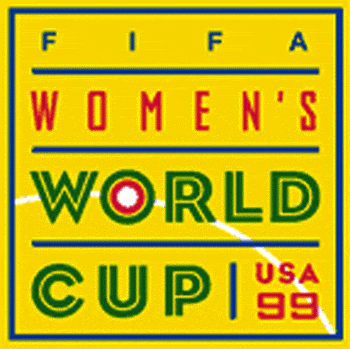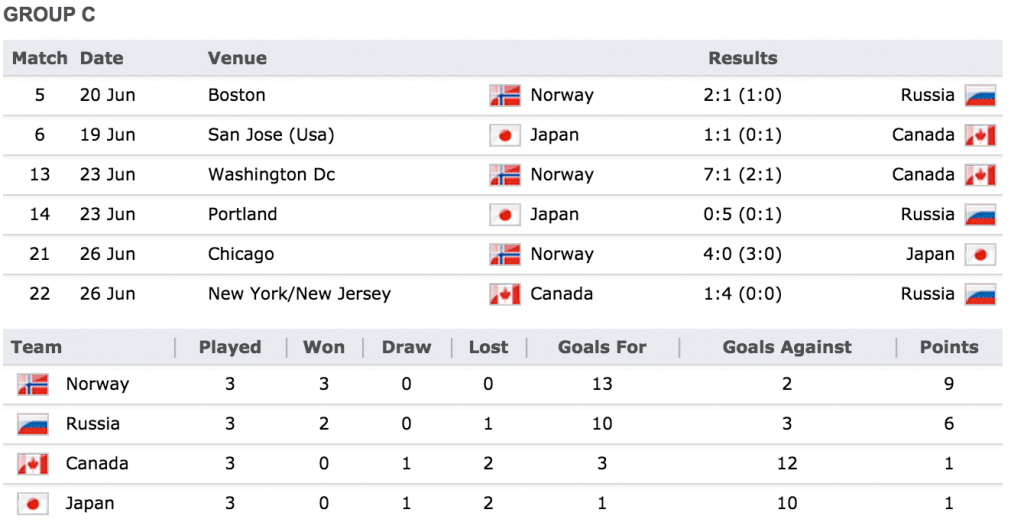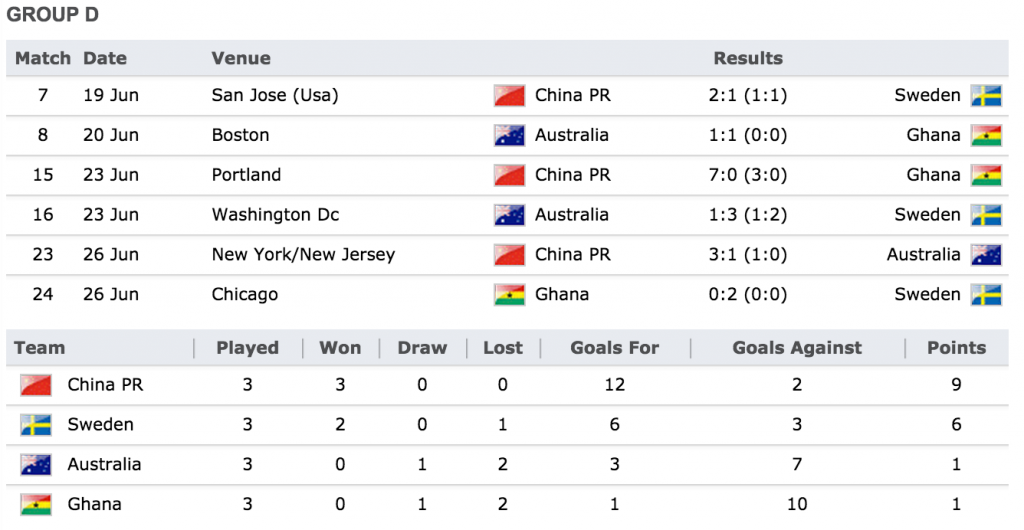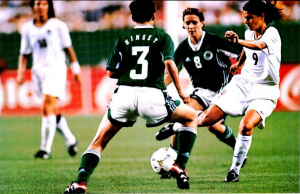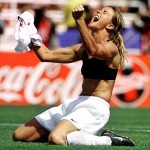Written by Ben Taylor
Host: U.S.A. (first time)
Dates: June 19 – July 10
Winner: U.S.A.
Golden Ball (Best Player): Sun Wen
Golden Boot (Highest Goal Scorer): Sissi, Sun Wen (7 goals each)
1999 Women’s World Cup Logo (Wikimedia Commons)
Leading Up to the 1999 Women’s World Cup…
A Turning Point in Women’s Soccer
The 1999 is often considered the pinnacle of women’s soccer in the United States. Other nations too highlight 1999 as the greatest Women’s World Cup, and try to recreate the explosion of interest seen in America that summer (Roh). The 1991 and 1995 World Cups garnered little international media attention, with American players having to fax game scores to their friends and family back in their title winning effort in 1991. Most people did not even know there was a World Cup going on, with friends of the U.S. players stating they didn’t even know the U.S. had a women’s team when they were told the U.S. women were world champions. In fact, when the title-winning team returned to the United States, the welcoming party consisted of four people plus baggage handlers (Longman, 71). The 1995 World Cup has similar low interest levels. However, the 1996 Olympics change the tide, as the team won the Gold Medal “in front of 76,489 screaming fans in Athens, GA.” Still, the game was not heavily publicized nationally, with NBC televising few moments of women’s soccer throughout the tournament (Penner). As the U.S. women were pulling out an incredible 2-1 victory in the championship, NBC instead aired a men’s gymnastics exhibition (Bokram, 42, ctd. in “1999 Women’s World Cup”). Despite the relative lack in TV coverage in 1996, the upward trend in interest resulted in much more hype and a far greater spectacle in 1999 than anything seen before in women’s soccer.
U.S.A. as Hosts
The Americans had won the 1991 World Cup, finished third in 1995, and won the Olympics in 1996. The choice of the U.S. as hosts was an obvious one, and the U.S. Soccer Federation and their women’s team wanted to build on the momentum from 1996 Olympics. In order to do so, they went a grassroots marketing crusade to spread the word to America that the women on the national soccer team “were a great combination of gritty world class athletes and equally powerful role models for every little girl in the United States” (Roh). Those in charge of the U.S. World Cup also made efforts to treat the 1999 World Cup as the biggest event possibly, most notably choosing to hold the games in the biggest stadiums possible, despite the concern that they would not be able to fill these stadiums. Marla Messing, the chief organizer of the Women’s World Cup, explained this decision, stating:
Our choices in this country are stadiums with 5,000 or 10,000 seats, or stadiums with 50,000, 60,000, or 80,000 seats. Once you decide on 5,000 or 10,000 seats, the image of what you are selling is second class. Putting it in small stadiums would have sealed the fate of the tournament. You had to sell he image of a major event. Right away it was major because it’s at Giants Stadium and the Rose Bowl (Longman, 31).
The hype of a major Women’s World Cup built largely through grassroots advertising at youth soccer events resulted in over 200,000 tickets sold by December of 1998. Major corporations soon jumped on board, and commercials for the World Cup and the American team sponsored by Adidas, Bud Lite, Gatorade, and Nike infiltrated the television waves throughout the months leading up to the World Cup (Longman, 32-34). All this would led to the highest average attendance (37,319 per match) and TV ratings ever in the Women’s World Cup (MLSsoccer, FIFA).
Mia Hamm gatorade advertisement from 1999 (Rosiesays)
Expansion – Moving from 12 to 16 Teams
In addition to attracting bigger crowds and media attention, the 1999 Women’s World Cup also expanded from 12 to 16 teams, demonstrating the increase in interest in international women’s soccer (Roh). This helped four teams who had never qualified before qualify, in Ghana, North Korea, Russia, and Mexico. Additionally, it resulted in a more sensical qualification to the group stages, with the top two of each four-team group qualifying, instead of the precedent of top two qualifying in some groups and three in others (FIFA).
Favorites
China, Norway, and the United States came into the 1999 World Cup as favorites, having each finished in the top four in both the 1995 World Cup and the 1996 Olympics. The United States finished third in 1995 and won the gold medal in 1996. Norway did the opposite, winning the World Cup in 1995 and the bronze in 1996. China was yet to win a major tournament, but reached the semifinals in 1995 and the finals in 1996, giving the U.S. a good test before ultimately falling in both (Langdon).
Group Play:
Group A (USA, North Korea, Nigeria, Denmark)
The United States started off group play with a bang, beating Denmark 3-0 in front of 78,972 fans in Giant Stadium – the second largest crowd ever held in Giants stadium, only behind the Pope’s visit in 1995. At the time this was the largest crowd ever to see a women-only sporting event (The Economist). The rest of the group stage was merely a formality – a battle for second. The United States dismantled Nigeria 7-1 and North Korea 3-0 to end the group stage perfect, with 13 goals from nine different scorers for and only one against (FIFA).
The battle for second place was a fierce one. North Korea and Nigeria began the the battle in their first game against each other, in which Nigeria won a back and forth battle with a 79th minute winner from Rita Nwadike (FIFA). Despite this win, they went into the final round of group games in third place on goal difference after being demolished 7-1 by the United States. North Korea just had to stay even on points with Nigeria to advance, as they likely would have the superior goal difference. However, the USA took care of business against North Korea, and Nigeria decisively won 2-0 against Denmark and advanced to their first World Cup quarterfinals (FIFA).
Group A Results and Standings (Courtesy of FIFA)
Advanced: USA, Nigeria
Group B (Brazil, Germany, Italy, Mexico)
Group B consisted of Olympic bronze medalists, Brazil, top-seeded Germany, Italy, and Mexico, and was arguably the strongest group, and thus labeled the “Group of Death” by the media (FIFA). Germany and Italy set the tone for the rest of the group stage when they drew 1-1 in their opening match. After being eliminated in the group stages of the 1995 World Cup, Brazil was considered to be one of the most improved nations in the world, and showed in their opening match when they destroyed Mexico 7-1, led by a hat trick from their star Sissi. Still, top-seeded Germany had the the group won, as they went into injury time against Brazil with 3-2 lead, but Brazilian Maycon managed to score a goal in the fourth minute of injury time to clinch a first place finish, forcing the Germans to play Group A winners and tournament favorites USA in the quarterfinals. Italy beat Mexico in their final game, but would have needed a German loss paired with lopsided win to level themselves on points and make up the major goal differential gap between the two teams (FIFA).
Group B Results and Standings (Courtesy of FIFA)
Advanced: Brazil and Germany
Group C (Norway, Russia, Canada, Japan)
Group C looked as if it could be close to start, when Norway narrowly beat Russia 2-1 and Japan drew Canada 1-1. However, any semblance of parity quickly evaporated, as Norway went on to beat Canada 7-1 and Japan 4-0. Russia similarly breezed through its other group-mates, beating Japan 5-0 and Canada 4-1. Norway and Russia both left group C looking like formidable opponents – which was expected for heavyweight Norway. Russia was a bit of a surprise, as 1999 was their first World Cup appearance. In any case, two strong teams moved on from Group C ready for the quarterfinals (FIFA).
Group C Results and Standings (Courtesy of FIFA)
Advanced: Norway and Russia
Group D (China, Sweden, Australia, and Ghana)
Group D mirrored group C in many ways, opening with two close matches, a 2-1 victory for China over Sweden, and a 1-1 draw between lightweights Australia and Ghana. Sweden got off to a dream start with a goal in just two minutes from Kristen Bengtsson, but the powerhouse Chinese came back from a 2-1 victory. From there on out, China dominated, led on by Golden Ball winner Sun Wen’s four goals, beating Ghana 7-0 and Australia 3-1 in their next two matches. Sweden similarly took care of business, beating Australia 3-1 and Ghana 2-0. However, their victory over Ghana was costly, losing their great defender Hanna Ljungberg for the rest of the tournament to injury (FIFA).
Group D Results and Standings (Courtesy of FIFA)
Advanced: China and Sweden
Knockout Stages:
Knockout stages bracket (courtesy of Wikipedia)
Quarterfinals
The quarterfinals were stacked with talent and pedigree – five of the eight teams which qualified for the quarters had taken part in each Women’s World Cup, and all of the favorites in Norway, China, and USA each easing into the knockout stages. The quarterfinals also had some newcomers, such as Nigeria, the first African team to ever make the knockout rounds. Nigeria’s qualifying represented the globalization of women’s soccer, and development of women’s soccer in new places (FIFA, “Technical Report” 70).
The host nation began the quarterfinals with one of the best and most exciting games of the tournament, defeating the Germans 3-2 in closely contested match. USA got off to a rough start, conceding an own goal form Brandi Chastain following a breakdown between Chastain and her goalkeeper on a ill-judged back pass. However, the U.S. soon settled in and took control of the game, but still went into halftime down 2-1. The second half was very evenly contested, but the US team prevailed on headers from Chastain and Joy Fawcett in the 49th and 66th minutes. The U.S. then held on for the victory, advancing into the semifinals (FIFA; FIFA, “Technical Report” 71-72).
The next game may have been even more remarkable, as Brazil beat Nigeria 4-3 in extra time after an incredible Nigeria comeback. The Brazilians dominated the first half, as their star Sissi assisted the first two goals scored by Cidanha. Nene scored the third goal, as Nigeria’s goalkeeper let her long-distance shot slip through her hands (and was promptly subbed out before halftime). However, the Brazilians came out weakly in the second half, as if they had already won and the Nigerians took advantage, dictating play and dominating the game. Three separate Nigerian players scored in the second half to even the score and send the game to extra time. The Brazilian’s again leaned on their outstanding player Sissi, who came through with a golden goal winner in 104th minute on a free kick, advancing the Brazilians to the semifinals (FIFA; FIFA, “Technical Report” 71).
The second two semifinal matches did not offer the same excitement, with Norway beating Sweden 3-1 and China cruising past Russia 2-0. Sweden dominated possession against Norway early in the match but the Norwegian defense held tight on gave the Swedes few chances at goal. The second half saw Norway take a more positive approach, switching momentum and scoring the first three goals before Sweden could grab a consolation goal (FIFA, “Technical Report” 70-71). China dominated throughout against Russia, as they were the only team attacking throughout, as Russia was pinned back trying to park the bus in front of their own goal. The Russians’ negative tactics were employed in attempt to keep the game close and thus qualify for the 2000 Olympic games (three quarterfinal losers would qualify). Nevertheless, the Russians were hurt by their supposed pragmatism, as they lost with no real attacking threat, and failed to qualify for the Olympics (FIFA, “Technical Report” 70).
Mia Hamm weaves her way through the German defense (FIFA)
Semifinals
The semifinals saw the three favorites and old adversaries in China, Norway, and the US meet up with Brazil, the newcomer knocking on the door to legitimacy. The matches both took place on July 4th, the host nation’s independence day. On the national holiday, 73,123 fans poured into Stanford Stadium to see their American heroes play (Longman, 33). The Brazilians provided stiff competition for the hosts in their first semifinal appearance. They conceded an early US goal, but after that impressed, controlling much of the game with their brilliant, short-passing, high-energy game. However, the US kept their slim lead thanks to a goal-line clearance by Michelle Akers and an impressive save by Briana Scurry. Late in the game, the Brazilians faded, paying the price for their high-energy style. They had a number of defensive lapses, with one leading to foul in the box on Mia Hamm. The penalty was converted by Akers, who once again came in clutch for the Americans, and allowed the 70,000+ spectators to go home happy on independence day following the US’s 2-0 victory (FIFA, “Technical Report” 66).
Whereas the Americans had to work hard, the Chinese cruised into the final. The 1995 world champions Norway were easily denied their third trip to World Cup final. China was clearly the superior team throughout, demonstrating their dominance both through intricate passing and direct attacks. Sun Wen again showed her class, scoring two of the five goals. The dominance was surprising, as Norway was one of the favorites heading into the tournament, and the defending champions. However, they were no match for the Chinese, determined that no one would stand in their way to their first World Cup Final (FIFA, “Technical Report” 66).
Sun Wen dribbling (Women in Sport)
Final
On July 10, 1999 90,185 people streamed into the Rose Bowl to watch the United States face off against China in a game for the centuries. To this day, the crowd is the largest ever for a women’s only sporting event. 40 million more watched the game on ABC, as it also remains the most watched women’s sporting event in history (Kelly). The game lived up to the hype and somehow delivered even more, as the teams played an incredibly close game, with both teams refusing to lose.
The Americans got the game under way at a breathtaking pace, attempting to deny China the time and space needed to settle into their intricate passing game. This worked well for the first fifteen minutes, as the US team controlled the game and possession. However, they did no manage any clear cut chances with their possession. After 15 minutes the game evened out and the game devolved into a battle for midfield supremacy (FIFA, “Technical Report” 59). The Americans narrow 4-3-3 gave them an extra forward and central midfielder; however, the Chinese conventional 4-4-2 gave them the advantage on the wings (Longman, 74-75). Despite their differing formations, little space opened up for either team, as both seemed more concerned with closing down the opponent, trying to stop any dangerous attacks instead of creating their own. As a result, the game moved into extra time scoreless (FIFA, “Technical Report” 59).
In extra time, the Americans had more possession and seemed to be controlling the game, but China was the team that came closer to scoring the Golden Goal. The Chinese almost scored when an impressive header by Jin Yan from a corner had to be cleared off the line by Kristin Lilly to keep the game going. Extra time was intense and exhausting, with several players noticeably fatigued in the hot California Sun. Still, no one scored, so the game moved on to penalty kicks (US Soccer).
Lauren Gregg, the American assistant coach, spent most of extra time contemplating on the list and order of penalties. It was made harder by the fact the Americans’ usual first-choice penalty taker Michelle Akers had been removed in overtime, so exhausted that her jersey had to be cut off with a pair of scissors. The American coaches ended up decided easily on the first three takers, Carla Overbeck, Joy Fawcett, and Kristine Lilly. The final two were harder; Mia Hamm was given the fourth spot despite her admittance of nervousness in her refusal to take the penalty kick against Brazil in the game. When it came down to it, Tony DiCiccio, the American’s head coach, said, “Can you imagine not putting in the world’s greatest scorer?” (Longman, 8). Hamm actually tried to convince the coaches to have another player shoot for her, but they were adamant – she would be one of the five. For the fifth spot, Gregg was contemplating two names, Brandi Chastain and Julia Foudy. Chastain had a good penalty record, but was becoming predictable, shooting each penalty to the right of the keeper with her right foot. DiCiccio decided he wanted Chastain as number five – if she would kick her left. She obliged and confidently committed to scoring (Longman, 2-10). The Chinese elected for Xie Huilin, Qui Haiyan, Liu Ying, Zhang Ouying, and Sun Wen to be their penalty takers (FIFA).
Both teams coolly converted their first two kicks. Then on China’s third Scurry decided, “this is the one” – later stating she could saved it with her “eyes closed… that’s how sure I was” (Longman, 271). Liu Ying went left and Scurry was right, she had it covered, getting both hands to the ball. All the US now had to do was convert their last three kicks – easier said than done. Lilly coolly converted her kick, and Zhang Ouying followed suit. Hamm was now up, despite not wanting to take the kick, and managed to overcome her nerves and convert into the bottom right corner after a long run-up. Sun Wen, the Chinese star, converted her shot and it was now all up to Chastain. She stepped up confidently, and drove the ball into the ball into the right netting with the laces of her left shoe. After that it was pandaemonium – the crowd went wild as she removed her jersey to celebrate, creating on of the most iconic sports pictures of all time (Longman, 270-272).
Brandi Chastain rips off her shirt to celebrate her winning penalty (All White Kit)
Aftermath
The 1999 World Cup set countless records for attendance and TV viewership, many that are still yet to be broken today. More importantly, it was not a one-off event, it also put women’s soccer on the map going forward, garnering increased media coverage and international attention for future tournaments (Miller). The US players became celebrities and role models, appearing on latenight shows and becoming some of the most recognizable faces in all of sport (Longman, 34, 308).
The success of the 1999 World Cup also resulted in the founding of the Women’s United Soccer Association (WUSA). While the league failed after just three seasons, it set the groundwork for future women’s soccer leagues. Additionally, the fact that there was enough interest to even found the league would have been unheard of prior to the 1999 success (Longman, 309-319).
However, the most significant legacy of the 1999 World Cup was not the records broken or the foundation of a profession women’s soccer league. Its greatest achievement was captivating the nation and the world, demanding attention for the athletic prowess and accomplishments of women. The ’99 World Cup gave a generation of young girls strong, female athlete role models, while forcing everyone, even those who were previously against women’s sport, to pay attention to the athleticism, accomplishments, and ability of female athletes (Miller – for more on the aftermath of the 1999 World Cup, follow this link).
Return to History of the Women’s World Cup Main Page.
How to cite this article: “1999 Women’s World Cup” Written by Ben Taylor (2015), History of Women’s World Cup, World Cup 2015 Guide, Soccer Politics Blog, Duke University, http://sites.duke.edu/wcwp/world-cup-guides/world-cup-2015-guide/history-of-the-womens-world-cup/1999-womens-world-cup/ (accessed on (date)).
Works Cited
“The Aftermath of the 1999 World Cup” Written by Gretchen Miller, Jonathan Scheyer, and Emily Sherrard (2009);edited and updated byChristina Malliris (2013), Women’s Soccer in the US, Soccer Politics Blog, Duke University, <http://sites.duke.edu/wcwp/research-projects/womens-soccer-in-the-u-s/womens-soccer-after-1999/>
All White Kit. “An Interview With Brandi Chastain.” All White Kit. All White Kit, 05 Dec. 2010. Web. 27 Apr. 2015. <http://www.allwhitekit.com/?p=4666>.
The Economist. “Girl Power Plays.” Economist 24 July 1999: n. pag. The Economist. The Economist. Web. 28 Apr. 2015. <http://www.economist.com/node/322851>.
FIFA. “FIFA Women’s World Cup.” FIFA.com. FIFA, n.d. Web. 27 May 2015. <http://www.fifa.com/worldfootball/statisticsandrecords/tournaments/tournament=103/index.html>.
FIFA. “FIFA Women’s World Cup USA 1999.” FIFA.com. FIFA, n.d. Web. 28 Apr. 2015. <http://www.fifa.com/tournaments/archive/womensworldcup/usa1999/index.html>.
FIFA. “Technical Report.” FIFA.com. FIFA, 1999. Web. 28 Apr. 2015. <http://www.fifa.com/mm/document/afdeveloping/technicaldevp/50/08/12/wwc_99_tr_part1_257.pdf>.
Kelly, Caitlin. “The Summer That Changed Women’s Soccer.” The New Yorker. The New Yorker, 20 Aug. 2013. Web. 28 Apr. 2015. <http://www.newyorker.com/news/sporting-scene/the-summer-that-changed-womens-soccer>.
Langdon, Jerry. “Women’s World Cup: U.S., China Share Favorites Role with Three Others Close.” SoccerTimes.com. Soccer Times, 8 June 1999. Web. 28 Apr. 2015. <http://www.soccertimes.com/worldcup/1999/jun08.htm>.
Longman, Jere. The Girls of Summer. New York, NY: HarperCollins, 2000. Print.
MLSsoccer. “Women’s World Cup Final Sets New US Television Record.” MLSsoccer.com. MLSsoccer, 18 July 2011. Web. 27 Apr. 2015. <http://www.mlssoccer.com/news/article/2011/07/18/womens-world-cup-final-sets-new-us-television-record>.
Penner, Mike. “U.S. Women’s Soccer Goal There for Taking.” Los Angeles Times. Los Angeles Times, 01 Aug. 1996. Web. 29 Apr. 2015. <http://articles.latimes.com/1996-08-01/news/ss-30189_1_olympic-soccer>.
Roh, Jerrod. “2011 FIFA Women’s World Cup Preview – Part 1.” IMSoccer News. IMSoccer News, 21 June 2011. Web. 28 Apr. 2015. <http://www.insidemnsoccer.com/2011/06/21/2011-fifa-womens-world-cup-preview-part-1/>.
Rosie Says. “Anything You Can Do.” Rosie Says. Rosie Says, 19 July 2011. Web. 27 Apr. 2015. <http://rosiesays.com/2011/07/19/anything-you-can-do/>.
US Soccer. “Scurry Save & Perfect PKs Secure Cup for U.S. Women.” USsoccer.com. U.S. Soccer, 10 July 1999. Web. 28 Apr. 2015. <http://www.ussoccer.com/stories/2014/03/17/11/32/scurry-save-perfect-pks-secure-cup-for-u-s-women>.
Wikipedia. “1999 FIFA Women’s World Cup.” Wikipedia. Wikimedia Foundation, n.d. Web. 28 Apr. 2015. <http://en.wikipedia.org/wiki/1999_FIFA_Women%27s_World_Cup>.
Women In World. “Top Best [sic] Female Soccer Players.” Women in World. Women in World, 15 Dec. 2012. Web. 28 Apr. 2015. <http://women-s-rights.blogspot.com/2012/12/top-best-female-soccer-players.html>.
“1999 Women’s World Cup” Written by Gretchen Miller, Jonathan Scheyer, and Emily Sherrard (2009);edited and updated by Gilda Doria (2013), Women’s Soccer in the US, Soccer Politics Blog, Duke University, <http://sites.duke.edu/wcwp/research-projects/womens-soccer-in-the-u-s/1999-womens-world-cup/>

